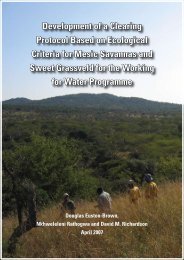Metsi Consultants - DWA Home Page
Metsi Consultants - DWA Home Page
Metsi Consultants - DWA Home Page
Create successful ePaper yourself
Turn your PDF publications into a flip-book with our unique Google optimized e-Paper software.
13.2.9 Tanzania<br />
Report No 678-F-001<br />
METSI CONSULTANTS: SUMMARY OF MAIN FINDINGS FOR PHASE 1 DEVELOPMENT<br />
Tanzania has initiated some IFA activities, and the new Water Policy has adopted the principle of a reserve from<br />
the RSA Water policy. Water resource projects presently coming into operation have not all had IFAs. The Lower<br />
Kihansi Hydropower Project on the Kihansi River, Rufiji Basin, was commissioned in July 2000 and is expected to<br />
lead to a loss of wetland habitat and the possible extinction of several threatened endemic species, including the<br />
Spray Toad. The EIA was limited to the effects of inundation and did not address the effects on the downstream<br />
river system in Kihansi Gorge. A constant bypass release averaging 2 m 3 s -1 (~12.5% of MAR) has been<br />
guaranteed and is being supplemented by an artificial sprinkler system. A 2-year flow release experiment<br />
involving a range of small to high flows will be used as a basis for establishing an IFR before a final water right is<br />
granted.<br />
13.3. ASSESSMENT OF INSTREAM FLOW REQUIREMENTS IN THE REST OF AFRICA<br />
The Sahelian Wetlands Expert Group is a network of 100 specialists comprising hydrologists, water engineers,<br />
biologists, physicists, pedologists, planners, human and animal health experts, ecologists, sociologists, legal<br />
experts and agro-foresters working in the Sahelian region of West Africa. Its primary goal is to improve the<br />
management of water in this region. Guidelines and a manual have been developed for use by planners and<br />
decision makers in West Africa. Projects include the successful introduction of artificial flood releases from dams<br />
to the Diawling National Park on the Senegal River in Mauritania, and the Waza Logone wetlands on the Logone<br />
River in Cameroon, which restored biodiversity and the associated livelihoods of communities dependent on the<br />
floodplains.<br />
In Nigeria, an economic valuation of the Hadejia-Nguru wetlands has found that the waters from the Hadejia-<br />
Jamare River basin, which are dammed to provide irrigation for cereal crops, could more productively be used to<br />
sustain the wetlands. The Hadejia-Jamare River Basin Development Authority is experimenting with managed<br />
flood releases.<br />
In Ghana, the Akasombo Dam on the Volta River has changed downstream flows to the extent that the coastlines<br />
of Togo and Benin have eroded at a rate of 10-15 m a year due to trapping of sediments. No IFAs have been<br />
done although flows for irrigation and domestic water abstraction have been addressed. There is a growing<br />
awareness of the need for IFRs following the impact of high dry-season or constant flows on Egeria populations<br />
and Bilharzia in the Volta Estuary.<br />
The Manantali Dam on the Senegal River in Mali was designed to provide irrigation to the Senegal River Basin,<br />
and to generate electricity for Mali, Mauritania and Senegal. The Diama Dam, 50 km upstream of the mouth of<br />
the Senegal River, was built to prevent salt water from intruding into the river delta as a result of the construction<br />
of the Manantali Dam and to aid navigation. IFAs were not done before the dams were built. Since their<br />
construction there has been an increase in the prevalence and extent of urinary and intestinal Bilharzia<br />
(transmitted by Bulinus sp.) in the Senegal River basin, and upstream aquatic weed (Salvinia molesta)<br />
infestations have become a major environmental problem. A study of the environment in the valley was<br />
undertaken in 1978 but no EIA relating specifically to the dam impacts appears to have been conducted. The<br />
biodiversity of the deltaic ecosystems downstream of Diama Dam in the Diawling National Park has declined.<br />
Managed flood releases from the Diama Dam were introduced in order to restore the downstream delta. Floods<br />
are released to guarantee the hydraulic conditions necessary to maintain 50,000 ha of floodplain agriculture<br />
below the Manantali Dam, although during drought years, this figure is not always achieved.<br />
76

















